Searching for Billy the Kid and UFOs in southeastern New Mexico

- Share via
My travel buddy — the college kid, now the college graduate — was about to join the ranks of the employed, and that meant it was time for one more — and I hope not the last — road trip.
Andrew and I managed to log 1,247 miles in April on a six-day dash through southeastern New Mexico, but it was not so much about the drive as the destinations.
We were searching for outlaws and space aliens; we found them and so much more.
We knew from previous trips that northern New Mexico has the glamour spots; this corner of the state was grittier, with parched range land that stretched as far as the horizon.
Now and then we would see a windmill or stunted tree, but we had to drive farther and work harder to see the beauty here, which often lay beneath our feet or soared above our heads.
An industry blasts off
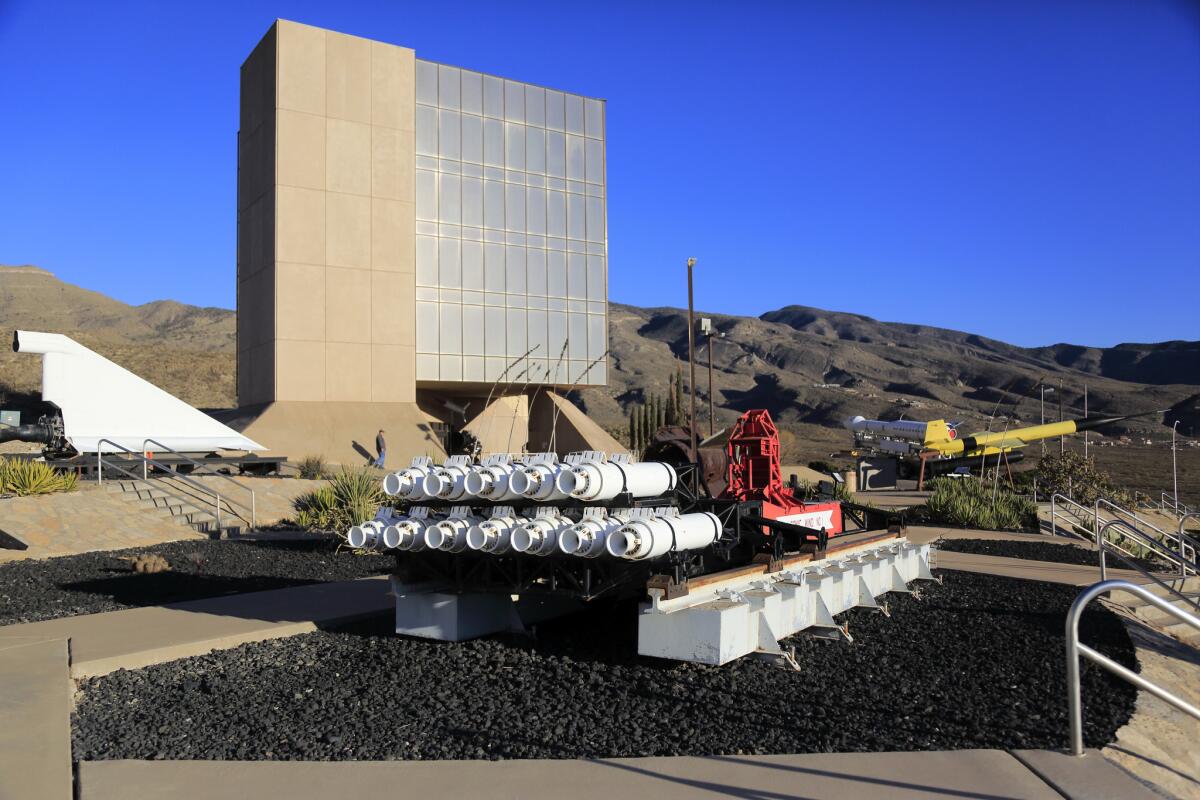
After flying to Albuquerque, we rented a car and, in deference to my son’s aviation obsession, headed for our first stop: the New Mexico Museum of Space History, a burnished gold cube on a bare hillside overlooking Alamogordo, N.M., about a 3½-hour drive.
The four-story museum spotlights the state’s role in the U.S. space program, beginning in 1930 with rocket tests outside Roswell and continuing today with nearby missile testing and space research.
We browsed through the Icons of Exploration gallery, which showcases replicas of early missiles and a real moon rock, which astronaut Jack Schmitt bagged in 1972.
The cube also is home to the International Space Hall of Fame, which featured an exhibit on “Star Trek” creator Gene Roddenberry, a recent inductee, as well as “Trek”-themed books, games and even Barbie and Ken dolls.
After the museum closed we headed outside, where an array of missiles and rockets, including a German V2 and the 86-foot Little Joe 2, the tallest rocket ever launched in New Mexico, was assembled.
After all that firepower, I welcomed the quiet of the small Astronaut Memorial Garden, dedicated to the crews of Apollo I and shuttles Challenger and Columbia, heroes all who died in service to the space program.
A small plaque nearby marked the grave of space pioneer Ham, the astrochimp launched into space on Jan. 31, 1961, as a dress rehearsal for NASA’s first manned space flight.
Billy the Kid was here
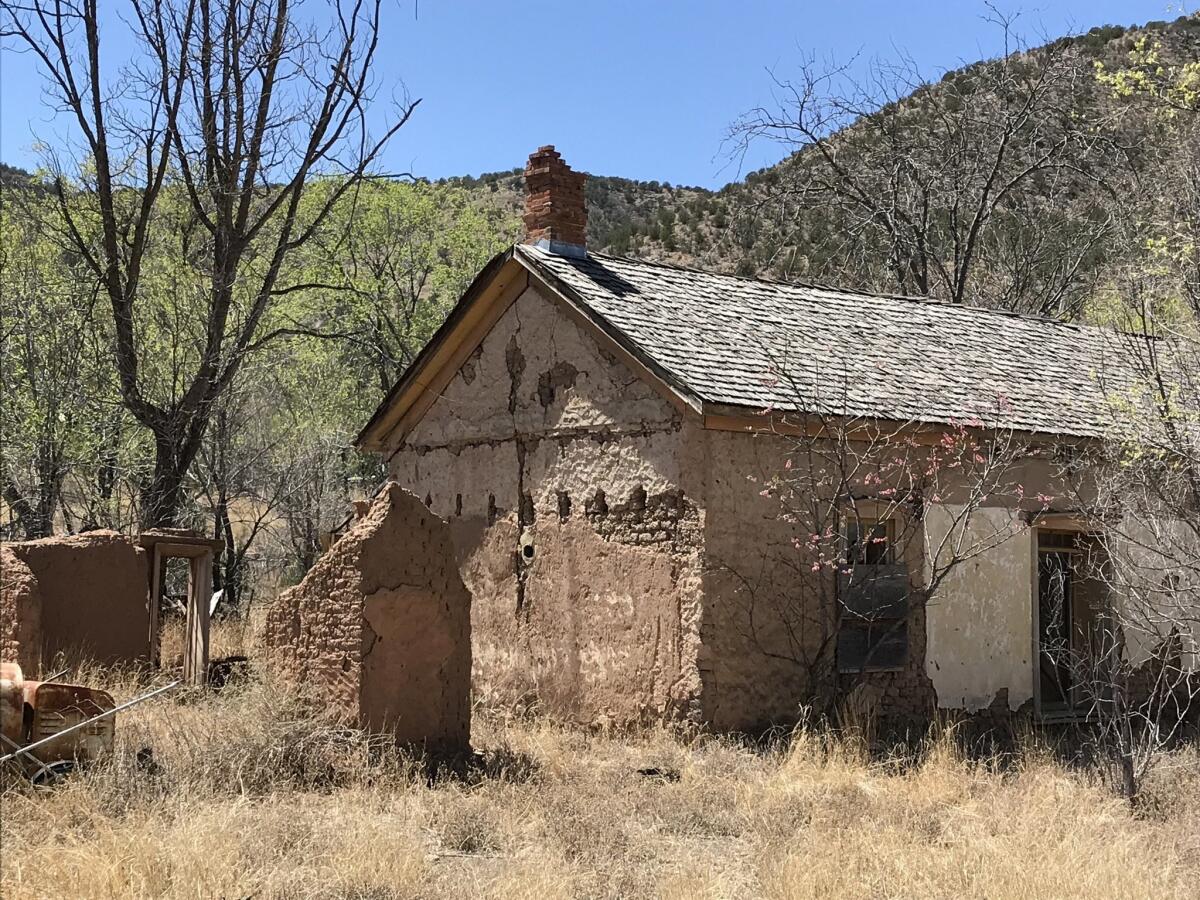
The next morning Andrew and I left Alamogordo for the village of Lincoln, a New Mexico Historic Site. The winding highway (U.S. 70) gradually gained elevation, and pine trees appeared as it cut through the Mescalero Apache Indian Reservation and the mountain resort town of Ruidoso.
We made a sharp left onto U.S. 380, the Billy the Kid Trail National Scenic Byway, and 10 miles later we were in Lincoln, the stamping ground of William H. Bonney, a.k.a. Billy the Kid, a drifter and cowboy.
Andrew had never heard of Billy the Kid — how is that possible? — so our first stop was the visitor center. We watched a video and studied exhibits on the area and Billy’s role in the Lincoln County War, including a five-day clash in 1878, between Lincoln’s merchants and ranchers, who controlled the region’s economy, and a wealthy newcomer who threatened their power.
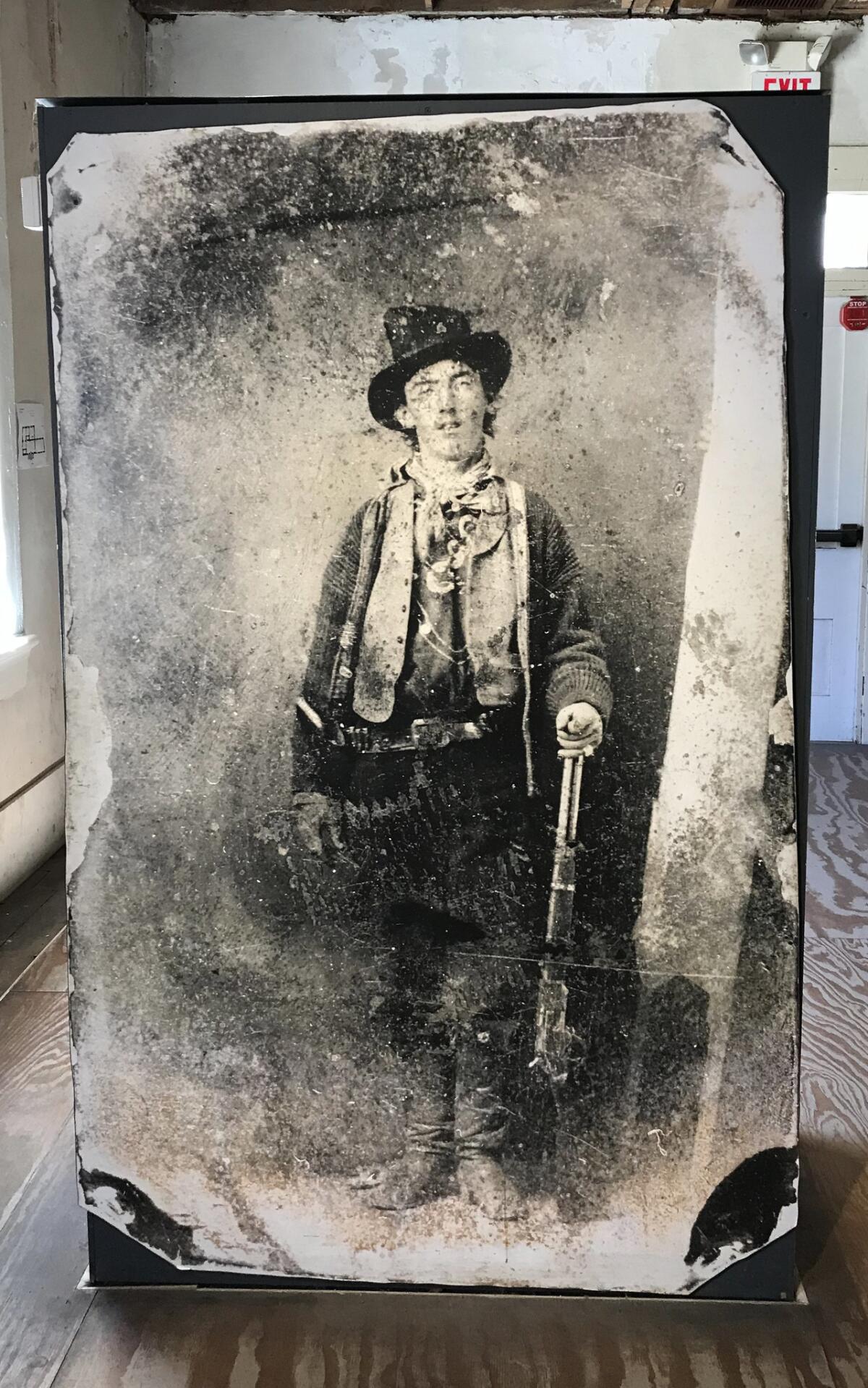
We spent several hours wandering in and out of Lincoln’s six small museums, which focus on various aspects of its history. The half-mile-long town was nearly deserted and seemed melancholy on a midweek afternoon.
Lincoln was livelier in Billy’s day — the town had several saloons — but he would have had no difficulty recognizing it today. The buildings — some restored, some in disrepair — look much as they did in the late 1870s and early 1880s. There are no street lights, fast-food joints or souvenir stands.
Territorial governor Gen. Lew Wallace had promised not to prosecute Billy for killing a local sheriff in exchange for his testimony in another murder case. Wallace reneged, and Billy was imprisoned in the Lincoln County Courthouse, where he awaited hanging in May 1881.
The courthouse, completed in 1874, has a museum on the first floor where copies of Billy’s pleas to Wallace are on display. There’s a bullet hole in one wall, thought to have been made when Billy escaped, still in shackles, after killing two deputies.
Tunstall’s store also was the site of violence during the Lincoln County War — its shutters were gunfire-proof — but it’s now a museum that focuses on the domestic life of the frontier. The mercantile, which opened 1877, contains original display cases and boxes of merchandise, including boxes of tea and spices, gas lamps, hardware, shirt collars and children’s high-button shoes.
All that history had made us hungry, so Andrew and I stopped for lunch at the privately owned Dolan House (1883), Lincoln’s only restaurant and a genteel respite. We ate our chicken salad sandwiches in the dining room, which, with its lace tablecloths, fresh flowers and bric-a-brac, would not be out of place in grandma’s house.
Watching the sky
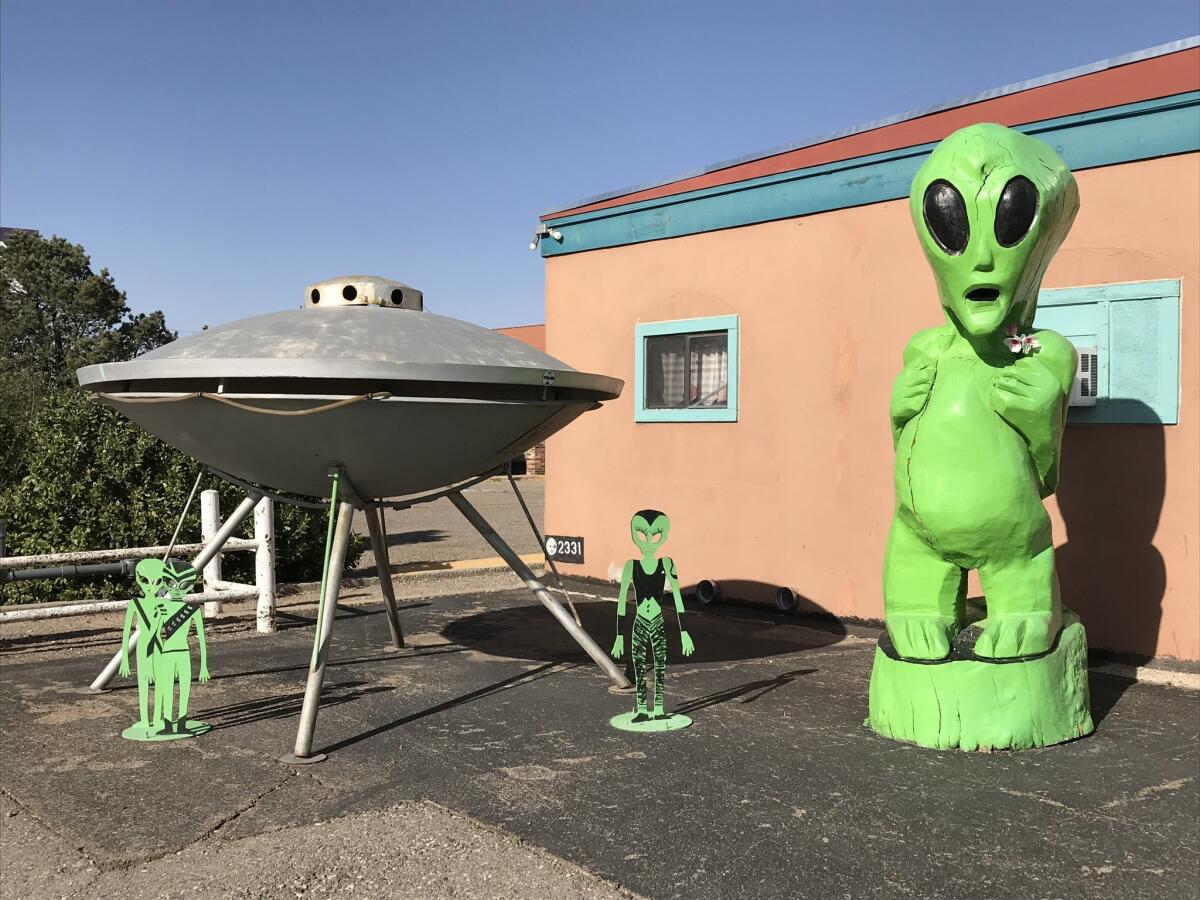
Roswell was beckoning, so we were back on U.S. 380 for about an hour’s drive east through more wide-open spaces.
In July 1947, an alien space ship was alleged to have crash-landed on a field north of town, an event that came to be known as the Roswell Incident.
Roswell clearly has embraced the story: Flying saucers and green space aliens pop up on murals, restaurant facades, a covered wagon and even a gas station canopy. Our favorite extraterrestrial sighting? The McDonald’s on North Main Street, which looks like a giant stainless-steel flying saucer.
At breakfast at the Cowboy Cafe, Andrew dug into his Alien omelet as he prepped me for our visit to Roswell’s International UFO Museum and Research Center by having me watch a YouTube interview in which astronaut Gordon Cooper had said he had spotted “literally hundreds” of UFOS while flying in Europe in 1951 for the U.S. Air Force.
The museum, in a remodeled movie theater, uses newspaper accounts, official-looking papers stamped “Top Secret” and interviews to document the UFO crash and the alleged government coverup.
But perhaps the biggest hit with visitors — it got a big laugh from me — was a display in the center of the museum with near-life-size animatronic aliens and a large flying saucer, which takes off and lands every 15 minutes or so amid clouds of vapor and colorful flashing lights.
History or hokum? We didn’t agree, but it was an amusing way to spend a couple of hours, and the admission price — $5 — was right.
Cemetery visit
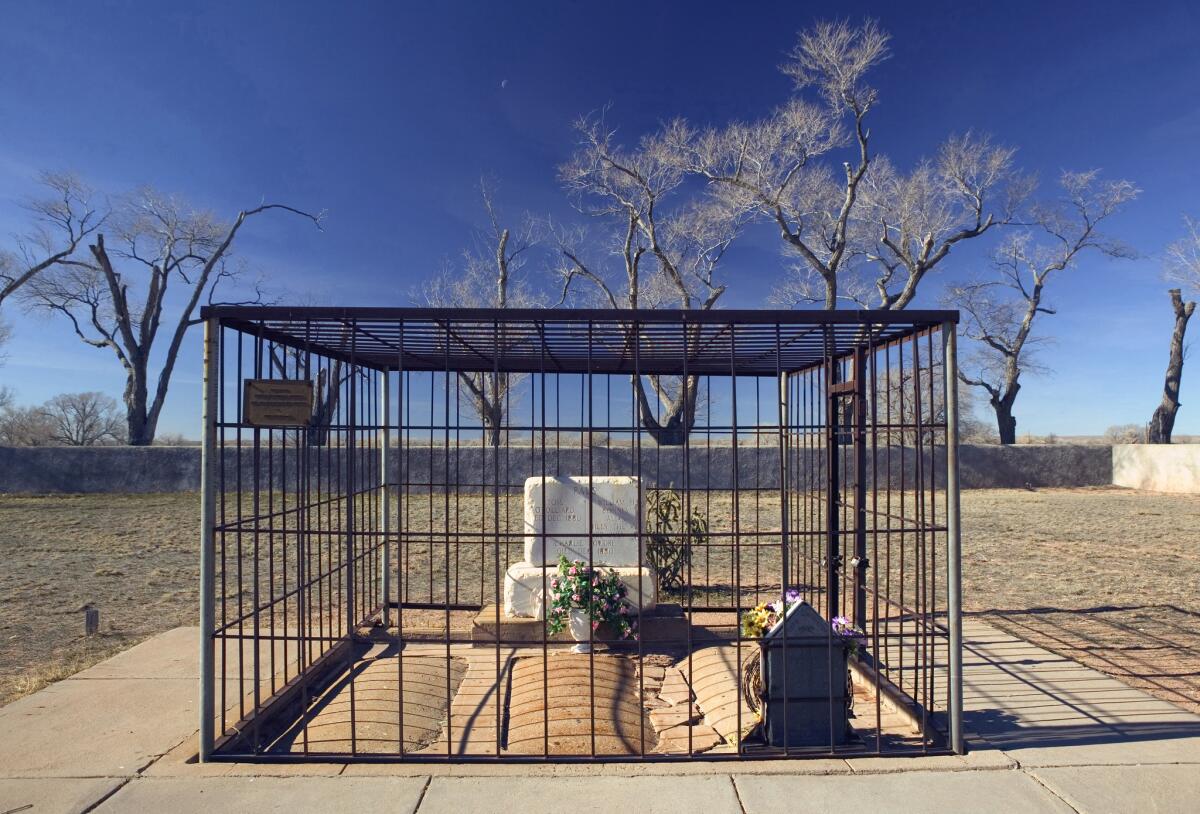
Sheriff Pat Garrett had tracked Billy the Kid from Lincoln northeast to Ft. Sumner, another New Mexico state historic site, and we did too, heading north from Roswell for an 85-mile drive through more desolate ranch land.
Garrett shot and killed Billy on July 14, 1881, in a private home (no longer standing) at the edge of the former fort’s parade grounds. His grave and those of two of his “pals” are nearby, enclosed in a metal cage to prevent the theft of his tombstone.
The dusty, sunbaked cemetery made me wonder whether Billy’s fate would have been different if Wallace had kept his promise.
From Ft. Sumner we backtracked through Roswell to Carlsbad, another long drive on U.S. 285.
Our destination that evening was the nine-room Trinity Hotel, a former bank building constructed in 1886 and restored in 2007.
To reach our room on the second floor, we had to climb an exterior metal staircase at the rear of the building. Although it was a bit noisy — I found a packet of earplugs in the bathroom — the room was comfortable despite having to vault into the too-high-off-the ground bed. Andrew slept on an air mattress.
But it was a welcome change from previous nights in chain hotels.
Dinner that night was in the Trinity’s dark, double-height dining room dominated by a large bar. I thought we had put the tale of Billy the Kid and Pat Garrett behind us, but no.
While we waited for our chicken piccata and fettucine amped up with Hatch green chiles, we read that later in his career Garrett had an office in the bank and collected debts on its behalf.
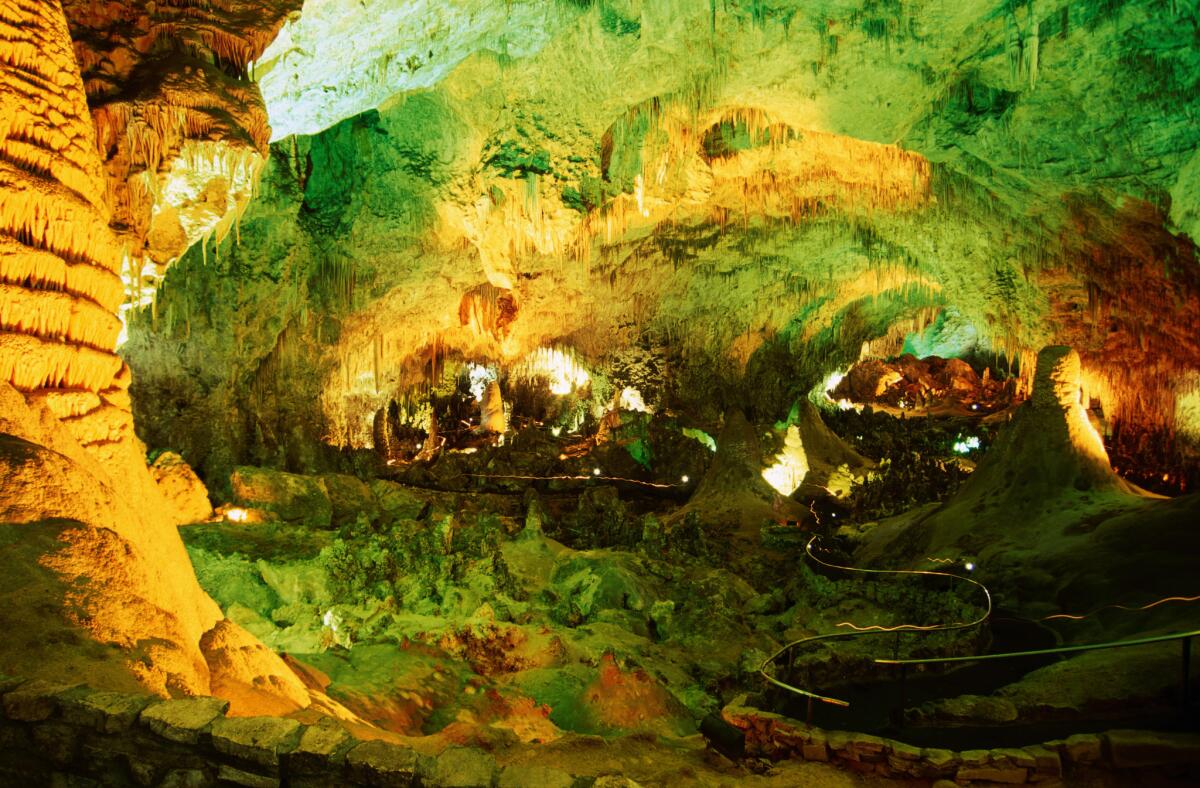
Carlsbad Caverns National Park is a 10-mile dash southwest of town, followed by a seven-mile drive to the visitor center. You reach the caverns, 750 feet below the surface of the Chihuahuan Desert, by an elevator or a strenuous trail that begins at a gaping opening called the Natural Entrance.
The elevator was out of order the day we visited. Andrew was up for the 1¼-mile stroll, but I wasn’t so sure. I’m not a hiker, but we hadn’t come this far to miss these subterranean wonders, so down the rabbit hole we went.
The Main Corridor took us past Iceberg Rock, a single 200,000-ton boulder, and the Boneyard, a maze of dissolved limestone, geologic highlights we otherwise would have missed.
Ninety minutes later we arrived in the lunch room and rest area, then headed to the gigantic Big Room and the self-guided 1¼-mile loop trail that encompasses more cave formations. We also took the ranger-led King’s Palace Tour ($8), soldiering on for a mile through four more scenic chambers.
I was dreading the climb back up, but after a pep talk from an asthmatic ranger, I huffed and puffed my way up the switchbacks and made it to the entrance in an hour and five minutes. I was elated, and the high-five from Andrew? Priceless.
Sand dunes ahead
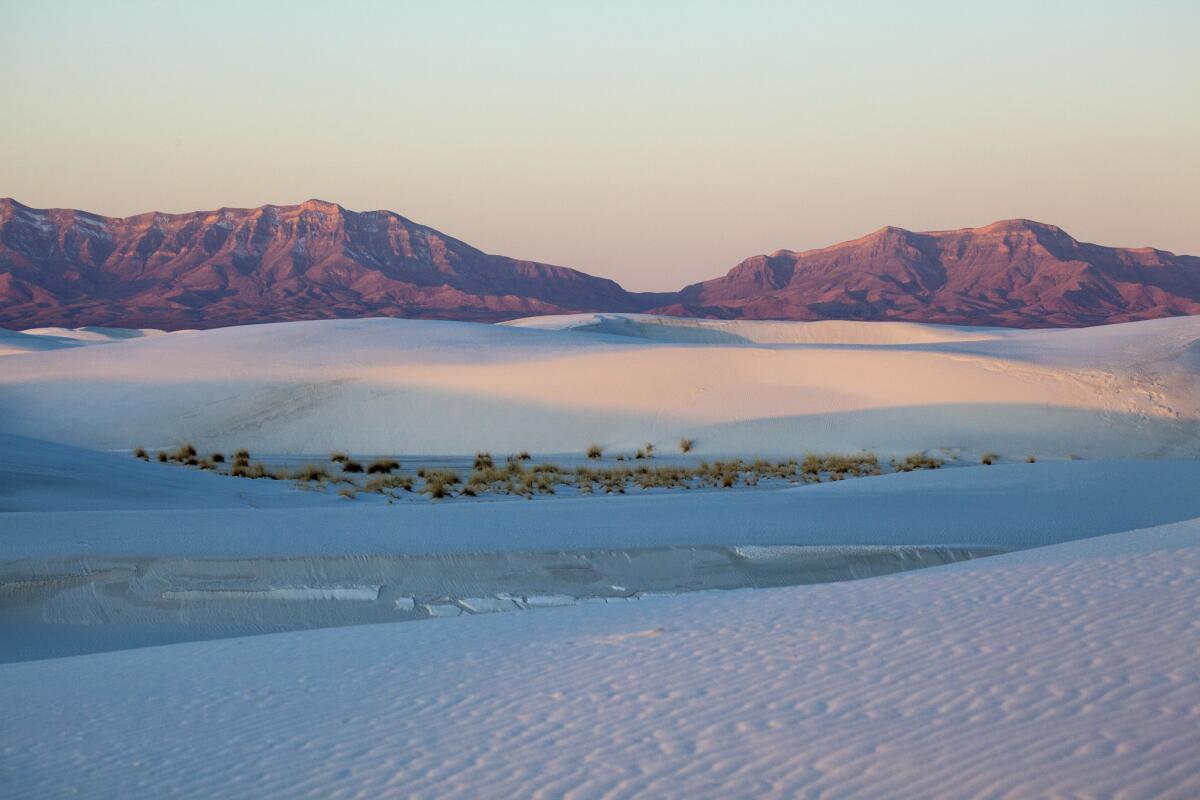
Our next destination was Las Cruces, N.M.,the three-hour drive through the corner of Texas was made enjoyable with aspirin and views of the purple-tinted Guadalupe Mountains.
That night shrimp tacos and a restorative jalapeño margarita at Garduño’s in the Hotel Encanto de las Cruces worked wonders for my aching knees.
Andrew was ready for another national park experience, so the next morning we made the easy drive east on U.S. 70 to the Tularosa Basin and its 275 square miles of shimmering white gypsum sand dunes, the largest in the world.
White Sands National Monument protects about half this area, which we experienced on a 16-mile loop drive from the visitor center.
Gypsum sand is firmer and denser than beach sand, making it relatively easy to walk on. A short boardwalk and a longer nature trail meant we could get up-close views of the dunes, soaptree yucca and other vegetation that survive the harsh environment.
The visitor center gift shop sells plastic saucers for sliding down the dunes — Andrew passed on that — but there’s another activity, courtesy of the U.S. Defense Department, travelers should be aware of.
The White Sands Missile Range surrounds the monument, which means it must close for several hours when there’s testing. Check the website or call the visitor center the day before your visit [(575)-479-6124, Ext. 236]. U.S. Highway 70 is often closed during testing; for information called the range at (575) 678-1178. In March, the monument was closed six times during missile testing.
In the afternoon we headed to the town of Mesilla just outside Las Cruces, in search of a store that sold New Mexico-made food. The shop had closed, but I was far from disappointed.
Andrew and I had seen plenty of strip malls, dollar stores and fast-food restaurants on this road trip, but Mesilla was different. It appeared to be from another century, and its central plaza looked straight out of Mexico: It was ringed with shops and restaurants and had a small bandstand in its center and a large church at the north end.
As we strolled around the plaza I had one one last encounter with Billy, whom I spied lounging on the wall of a dusty pink building. The Billy the Kid Gift Shop inhabits the courthouse where in April 1181 the outlaw was tried and sentenced to hang for killing the sheriff. He was the only person convicted of a capital crime related to the Lincoln County War.
The Mesilla Book Center, also on the plaza in a building that dates to the 1850s, is stocked with volumes on Western and New Mexico history, but the shaggy buffalo head and numerous handsome Native American rugs on the walls caught my attention.
We sampled the wares at Legacy Pecans & Co., an endeavor of the Salopek family that owns and operates 6,000 acres of orchards across New Mexico. And we wished we’d been able to catch a foreign or indie film at the 100-seat Fountain Theatre, which has been hosting plays, vaudeville and lantern slide shows since 1905.
Dinner that night was at La Posta de Mesilla. The restaurant, which opened in 1939 with four tables, now is a 10,000-square-foot collection of small and large dining rooms in an adobe compound that dates to the 1840s. Not to be missed: the large aviary filled with tropical birds and a fish tank stocked with a red piranha in the waiting area.
It’s a bit touristy, but the kids’ soccer teams and families celebrating birthdays didn’t seem to mind. And we didn’t either — it was a festive end to our road trip — but maybe La Posta’s chile ’ritas, made with blackberry-habanero syrup, helped.
If you go
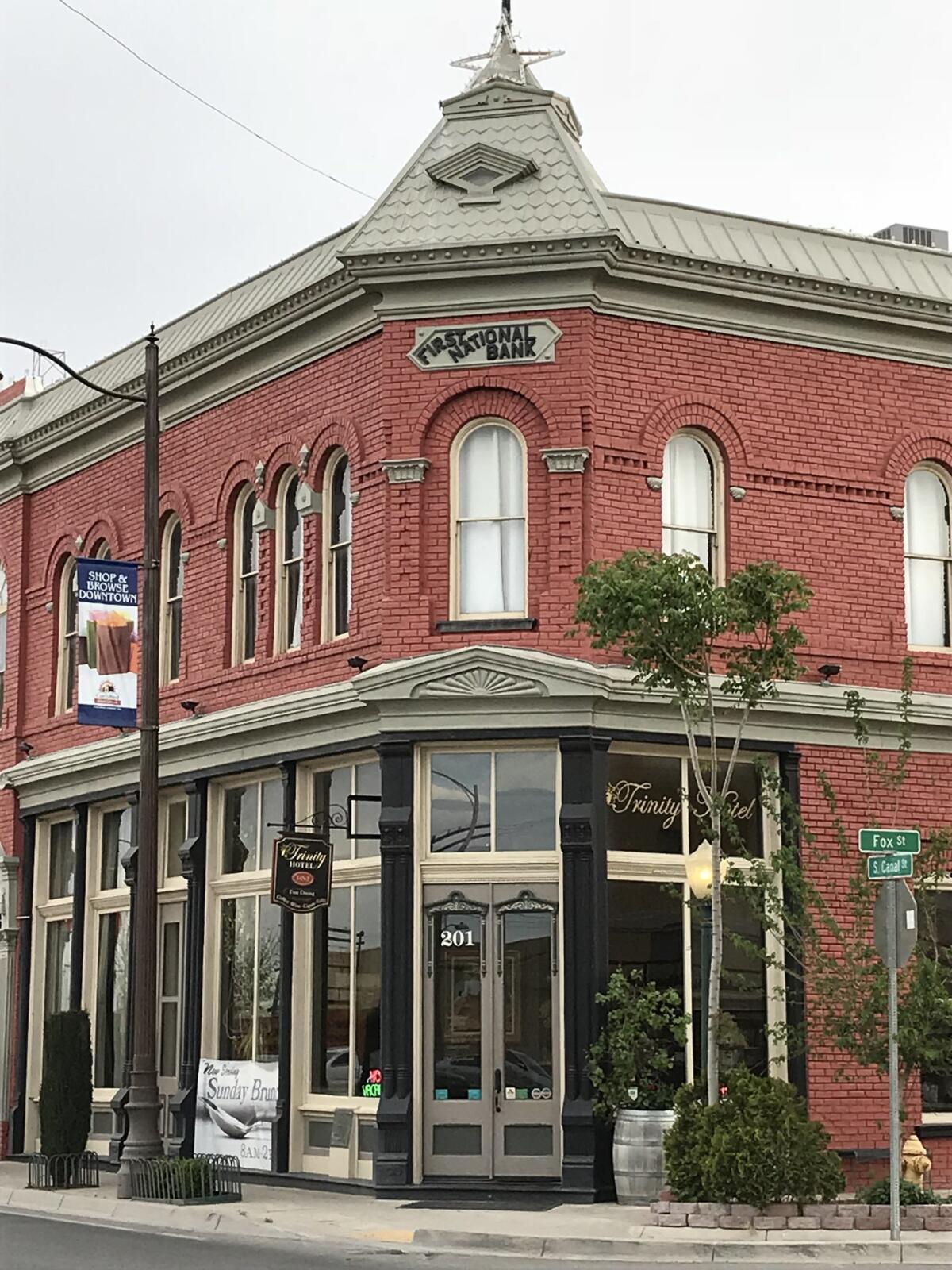
WHERE TO STAY
Trinity Hotel, 201 S. Canal St., Carlsbad, N.M.; (575) 234-9891. Historic hotel and restaurant on Carlsbad’s main street. Doubles from $189.
Hotel Encanto de las Cruces, 705 Telshor Blvd., Las Cruces, N.M.; (866) 383-0443. Doubles from $119.
WHERE TO EAT
Breakfast was by far our favorite meal of the day on this road trip. Here are four places we enjoyed.
Waffle & Pancake Shoppe, 950 S. White Sands Blvd., Alamogordo, N.M. Open daily 6 a.m.-1 p.m. Lively diner popular with locals and those stationed at nearby Holloman Air Force Base. Belgian waffle, $6.25.
Cowboy Café, 1120 E. 2nd St., Roswell, N.M.; (575) 622-6363. Open daily 6 a.m.-2 p.m. Small, friendly cafe across the street from Roswell Livestock & Farm Supply. Alien omelet, $10.49; Hot Rocks & Texas butter (biscuits and gravy), $5.99.
Blue House Bakery & Cafe, 609 N. Canyon St., Carlsbad, N.M.; (575) 628-0555, lat.ms/bluehousebakery. Open 6 a.m.-noon Mondays-Saturdays. Cute cottage with seating in front garden and wide porch. Breakfast burrito, $3.50; egg bowl, $3.50.
OMPC/The Shed, 810 S. Valley Drive, Las Cruces, N.M.; (575) 525-2636. Open 7:30 a.m.- 2 p.m. Wednesdays-Sundays. Where Las Cruces firefighters meet to eat. Breakfast enchiladas stuffed with pork or turkey sausage, $9.25; giant gingerbread pancake, $4.25 for one.
MORE EATS
Dolan House, 826 Calle la Placita, Lincoln, N.M.; (575) 653-4670. Open 9:30 a.m.-3:30 p.m. Fridays-Tuesdays. Homemade chili, soups, ham or chicken salad sandwiches from $8.95
La Posta de Mesilla, 2410 Calle de San Albino, Mesilla, N.M.; (575) 524-3524. Sprawling restaurant in a building that dates to the 1840s. Check out the tropical birds and piranha in the waiting area. Shrimp ceviche, $10.50; combination plate No. 1 with rolled enchilada and taco, tamale, red chile con carne, $10.95
WHAT TO DO
New Mexico Museum of Space History, 3198 State Road 2001, Alamogordo, N.M.; (575) 437-2840. Open 10 a.m.-5 p.m. Mondays, Wednesdays-Saturdays; noon-5 p.m. Sundays. Adults, $8; kids 4-12, $6.
Lincoln Historic Site, State Highway 380, Lincoln, N.M.; (575) 653-4372. Open daily 8:30 a.m.- 4:30 p.m. $5 for adults, kids free.
International UFO Museum and Research Center, 114 N. Main St., Roswell, N.M.; (575) 625-9495. Open daily 9 a.m.-5 p.m. $5 for adults, $2 for kids.
Ft. Sumner Historic Site/BosqueRedondo Memorial, 3647 Billy the Kid Drive, Fort Sumner, N.M.; (575) 355-2573. Open 8:30 a.m.-4:30 p.m. Wednesdays-Sundays. Free.
Carlsbad Caverns National Park, 77 Carlsbad Caverns Highway, Carlsbad, N.M.; (575) 785-2232. Summer hours: Visitor center open 8 a.m.-7 p.m. through Sept. 3. Adults 16 and older, $12; 15 and younger, free. Last entrance ticket sold at 4:45 p.m.
White Sands National Monument, Highway 70, Alamogordo, N.M.; (575) 479-6124. Adults 16 and older, $5; 15 and younger, free.
Sign up for The Wild
We’ll help you find the best places to hike, bike and run, as well as the perfect silent spots for meditation and yoga.
You may occasionally receive promotional content from the Los Angeles Times.




